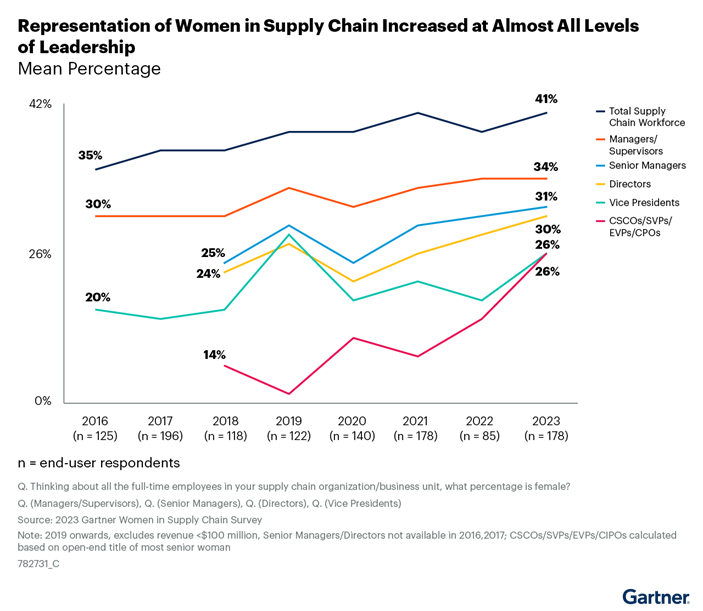Women have made a strong comeback to the supply chain workforce in 2023, with gains at nearly every level of leadership, according to a survey by Gartner, Inc. The advances were particularly prominent at the C-Suite and executive level, where 26% of those roles (CSCO, SVP, EVP, CPO) are now filled by women, an all-time high and up from 19% in 2022.
Gartner’s eighth annual Women in Supply Chain Survey was conducted from February to March of 2023 and surveyed 225 supply chain leaders. The survey showed that women now make up 41% of the supply chain workforce, up from 39% in 2022 (See Figure 1). However, frontline representation continues to lag, with women filling just 31% of these roles.
“It’s particularly encouraging to see women make gains at the senior executive level, as we know that when a woman holds the top supply chain position this has a positive correlation with more women in leadership and in all roles through that organization,” said Caroline Chumakov, Director Analyst in the Gartner Supply Chain Practice.
A sustainable comeback?
An increase in organizational goals around gender equality since 2020, as well as growth in the number of supply chain owned initiatives are clearly having a measurably positive impact on women in supply chain, Gartner concluded. The data suggests a virtuous cycle is possible as more women reach top leadership roles in their supply chain organizations, with a clear finding this year that a woman in the senior-most role leads to more women in leadership and all roles within the organization.
“This connection between female leaders and the effect on women in the workforce has positive implications for how supply chain leaders can better design their efforts to improve representation of women in supply chain,” said Chumakov.
Frontline challenges
Chief Supply Chain Officers (CSCOs) routinely report challenges with attrition broadly at frontline roles in manufacturing and logistics, particularly when compared to roles at desk-based jobs. The ability to attract more women to frontline roles—and especially in leadership roles in the physical operations ranks—could form a material competitive advantage over those who are unable to do so.
Providing flexibility was the most effective initiative in attracting and retaining women to frontline roles, significantly outperforming other areas such as benefits, employee engagement programs and even a focus on pay equity. However, only 41% of supply chain leaders had implemented an initiative dedicated to workplace flexibility at their organizations.
“There remains a mismatch between employers’ fears of chaos and instability as a result of workplace flexibility policies and the realities of what we see in our research and case studies of successful supply chain organizations. What we see in our research is that flexibility is benefiting both the organization and their female employees,” said Chumakov.
In addition to baseline data about the number of women at all levels of supply chain roles, Gartner asked questions about representation of women from underrepresented races and ethnicities, practices that increase the success of women in supply chain roles, pay equity and transparency, frontline engagement practices for women in on-site roles and attrition challenges specific to women.
Gartner partnered on the survey with AWESOME, a U.S.-based nonprofit organization focused on advancing women’s supply chain leadership and boom!, a U.K.-based global community formed to support and link women in the supply chain profession.
Gartner clients can learn more in: 2023 Women in Supply Chain Survey: Women Represented at Historic Levels. Nonclients can learn more in: Supply Chain Organization Design and Talent.
Article topics






